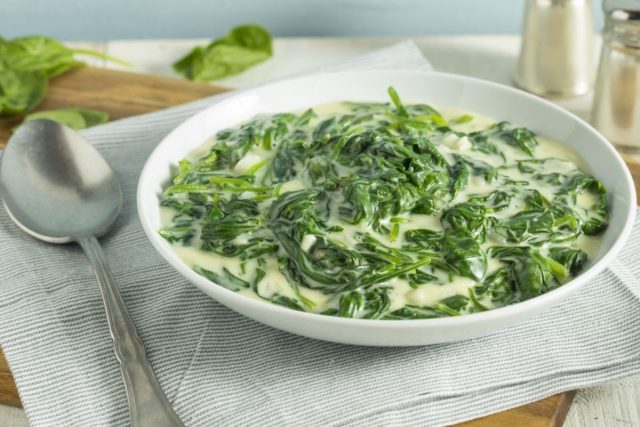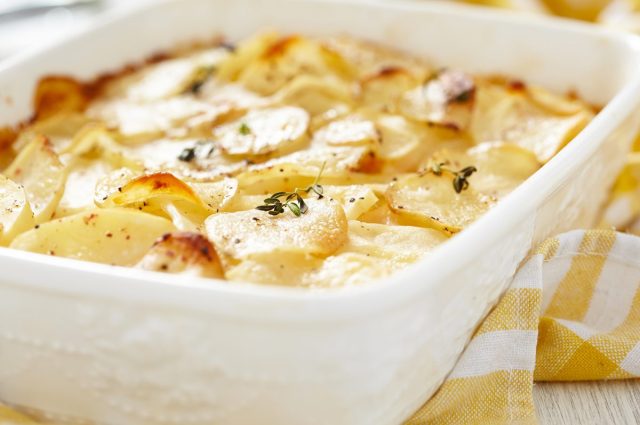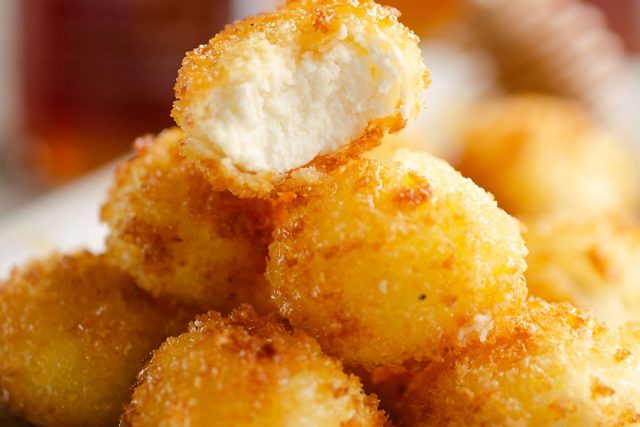Tis the season to eat, drink and be merry–and to remember that many of your holiday favorites can cause high cholesterol. In this story, we've ranked them by their saturated fat content, so you know which ones to enjoy–but limit. Why create such a naughty list? Because saturated fat is a type of fat that is solid at room temperature and is found in animal products such as meat and dairy products. There is evidence to suggest that consuming high amounts of saturated fat can increase the risk of certain health problems, such as heart disease and high cholesterol, according to the American Heart Association. This is because saturated fat can raise LDL (bad) cholesterol levels in the blood, which can contribute to the build-up of plaque in the arteries. Plaque build-up can narrow the arteries and increase the risk of heart attack and stroke.
"I think most doctors would agree that, if Christmas dinner was experienced with any regularity, chances are slim that many of us would make it past middle age," Dr. Michael Hirt, Board Certified in Nutrition from Harvard University and Board Certified in Internal Medicine, with The Center for Integrative Medicine in Tarzana California, tells us. "So, mind your stomach while being kind to your arteries."
It is generally recommended to limit saturated fat intake to less than 10% of your daily caloric intake. This means that if you need 2,000 calories per day, you should aim to consume no more than 200 calories from saturated fat, or about 22 grams of saturated fat.
It's important to note that saturated fat is not a nutrient that your body needs. Therefore, it is generally recommended to choose foods that are low in saturated fat and to limit your intake of high-fat animal products, such as fatty cuts of meat, high-fat dairy products, and fried foods—just the kind of things that make the holidays fun. Dr. Hirt says, "Here is a list of America's favorite holiday dishes ranked from 'healthiest' to 'heart-stopping.'"
Creamed Spinach

Saturated Fat: 0.7 grams
Creamed spinach can be loaded with calories because of the heavy cream, sour cream, cream cheese and/or Parmesan cheese many recipes call for. Dr. Hirt tells us, "Few veggies are as well known for building strong, healthy bodies than spinach, but the cream is the cringe factor in this holiday classic." If you enjoy creamed spinach, you can still include it as part of a healthy diet by being mindful of portion sizes and making sure to balance it with other nutritious foods. You can also try using healthier alternatives to cream, such as low-fat milk or plant-based milk, to reduce the fat and calorie content of the dish. Or cut the amount of butter in half. In addition, a dollop of reduced-fat cream cheese keeps this dish tasty.
Scalloped Potatoes

Saturated Fat: 2.26 grams
While they don't have heavy cream usually like other potato dishes, there is usually a ton of butter and cheese in scalloped potatoes, so grab a smaller spoonful and load up your plate with healthier options. Dr. Hirt says of scalloped potatoes: "These are the lesser of the traditional potato offerings because of the generous amounts of cholesterol-pumping cheese and butter that makes these such a crowd pleaser." There are several ways you can make healthier scalloped potatoes:
Use a lower-fat milk: Instead of using whole milk or heavy cream, try using a lower-fat milk, such as 2% or skim milk. You can also try using a plant-based milk, such as almond milk or soy milk.
Use a lower-fat cheese: Choose a lower-fat cheese, such as part-skim mozzarella or low-fat cheddar, to reduce the amount of saturated fat in the dish. You can also try using a combination of different cheeses for added flavor.
Add vegetables: Incorporate additional vegetables, such as bell peppers, onions, or mushrooms, into the dish to add flavor and nutrients.
Use a whole grain breadcrumb topping: Instead of using regular breadcrumbs, try using whole grain breadcrumbs for added fiber and nutrients. You can also try using rolled oats or crushed nuts as a topping.
Use a small amount of oil or butter: Instead of using a large amount of butter or oil, try using a small amount to reduce the fat content of the dish. You can also try using a lower-fat cooking spray or broth instead of oil or butter.
Mashed Potatoes

Saturated Fat: 2.6 grams
According to Dr. Hirt, "Potatoes themselves have no saturated fat, but it's what you 'mash' into them (butter, cream, margarine) that can turn these into 'terrible tubers.'" Mashed potatoes are a must at any holiday meal, so to make them a bit healthier, ditch the cream cheese or sour cream and use Greek yogurt instead. Also skip the heavy cream and use almond milk or a healthier milk option of your choice. Finally, many prefer to skin the potatoes, but by doing so you're not getting any of the nutrients, so leave the skin on to maximize the health benefits of the potatoes.
Eggnog

Saturated Fat: 2.79 grams
Eggnog is a rich, creamy, and sweet holiday beverage made with milk, cream, sugar, and eggs, and often flavored with spices such as cinnamon, nutmeg, and vanilla. It is traditionally served cold and is a popular drink during the winter holiday season in many countries. There are many variations of eggnog, but the traditional recipe calls for beaten eggs, sugar, and milk or cream to be mixed together and then chilled in the refrigerator. Some variations may also include alcohol, such as brandy, rum, or whiskey, although non-alcoholic versions are also available. "Doctors are generally grateful that this beverage is only enjoyed once a year. With its abundance of raw egg yolks, cream, and whole milk, eggnog is dangerously loaded with artery-narrowing saturated fat," says Dr. Hirt. "Add in the traditional spirits, and then you'll be loaded, too."
Deviled Eggs

Saturated Fat: 3 grams
A deviled egg is a hard-boiled egg that has been halved and had its yolk removed. The yolk is then mashed with mayonnaise and other ingredients, such as mustard or vinegar, and spooned or piped back into the egg white. They can be garnished with a variety of toppings, such as paprika, chives, or bacon bits. Dr. Hirt tells us, "Eggs are generally an innocent food choice, but once you add in the 'devil' (mayonnaise), the saturated fat content starts to climb. Notice the serving size (1/2 an egg), so these appetizers can push up your cholesterol in a hurry if you indulge more than a few of these tasty morsels."
That said, by swapping out the mayonnaise for Greek yogurt or even an avocado mash with cilantro for a Tex-Mex flavor you can reduce the calories and saturated fat in the popular appetizer.
Pumpkin Pie

Saturated Fat: 4.11 grams
The exact origins of pumpkin pie are not well-documented, but it is believed to have been first made by the Native Americans. Pumpkins were a common food for Native Americans, and they used the mashed flesh of the pumpkin to make a variety of dishes, including pies. The first recorded recipe for pumpkin pie appeared in an English cookbook in the 1650s, and it called for the pumpkin to be cooked and then mixed with milk, spices, and honey before being baked in a crust.
Dr. Hirt says, "As with the other 'veggies' on the holiday table, it's the sugar, eggs, and dairy (think butter and milk) that make this seasonal favorite a problem for your next blood test results." It's not a holiday meal without pumpkin pie so instead of using brown sugar, try Maple syrup. Also when shopping for pumpkin puree, the only ingredient should be pumpkin. If not, you can easily make your own at home.
Yule Log

Saturated Fat: 7.59 grams
Yule log is a traditional holiday dessert that is made by rolling a sponge cake into a cylindrical shape and then spreading a filling, such as whipped cream or buttercream, over the top and sides. The cake is then decorated with chocolate shavings or other toppings to resemble a log, and it is often served as a dessert during the Christmas season.
The Yule log has its roots in ancient pagan traditions, where a large log would be burned in the fireplace during the winter solstice as a symbol of the sun's return. Over time, the tradition evolved and the Yule log became a popular dessert in Europe, particularly in France, where it is known as a "bûche de Noël." There are many variations of the dessert, and the filling and toppings can be customized to suit individual tastes. Some common fillings and toppings include chocolate ganache, fruit, nuts, and candy. Yule logs are typically served chilled or at room temperature and are often accompanied by a festive holiday beverage, such as eggnog or hot cocoa.
Dr. Hirt says of the Yule Log: "This holiday dessert is made with buttercream, which is more fun to say than 'arterial plaque'…but in the end they both become one and the same."
Buttery Crescent Rolls

Saturated Fat: 11 grams
Crescent rolls are a type of pre-packaged, ready-to-bake rolls that are made from a soft, doughy dough that is shaped into a crescent shape. While crescent rolls can be a convenient and tasty snack or side dish, they are not necessarily unhealthy. However, like many pre-packaged and processed foods, they may not be as nutritious as whole, unprocessed foods and can be high in added sugars and unhealthy fats.
One potential issue with crescent rolls is that they are often made with enriched flour, which is a type of flour that has had some of the nutrients removed during the milling process and then added back in. Enriched flour is not as nutritious as whole grain flour and may not provide the same health benefits. Additionally, some brands of crescent rolls may contain additives and preservatives to extend their shelf life, and they may also be high in added sugars and unhealthy fats—ass you can see, 11 grams worth of saturated fat.
Dr. Hirt explains, "Breads are quite filling and generally a good choice for those looking to keep fat calories down, as long as someone hides your butter knife."
Prime Rib

Saturated Fat: 11.5 grams
Prime rib is a cut of beef that comes from the rib section of the animal. It is known for its tender, juicy, and flavorful meat and is often served as a special occasion or holiday meal. The prime rib roast is typically cooked by roasting it in the oven at a high temperature and then letting it rest before slicing and serving. Some common methods of cooking include slow roasting, reverse searing, and using a sous vide method. Dr. Hirt emphasizes, "At 700 calories per serving, this beast of burden is sure to be as hard on your waistline as it is on your arteries. Might I point out that most guests would think an 8 oz slice is a child's portion or permission for 'seconds.'' If your heart is set on this, the rest of your plate should be filled with salad, green beans, and, he adds jokingly about over-indulgence, "a statin pill."
Cheesecake

Saturated Fat: 13.3 grams
Cheesecake, as you may know all too well, is a dessert made with a mixture of cream cheese, eggs, sugar, and other ingredients that is baked in a crust and then chilled in the refrigerator. In moderation, cheesecake can be enjoyed as part of a healthy, balanced diet. However, like many desserts, it can be high in calories, fat, and added sugars, depending on the specific recipe and serving size.
One potential issue with cheesecake is that it is often made with full-fat cream cheese and other high-fat ingredients, such as butter or heavy cream, which can contribute to the calorie and fat content of the dish. Additionally, many cheesecake recipes call for a sugary crust or topping, which can add to the overall sugar content of the dessert.
Dr. Hirt says, "Any food item that contains more saturated fat in one serving than the rest of your meal combined does deserve at least a moment of guiltful reflection, and a promise to self that come January 1, you're going to find the number of that diet coach your best friend gave you last Christmas."
Cheese Ball

Saturated Fat: 14.6 grams
A cheese ball is a ball-shaped appetizer made with a mixture of cheese, cream cheese, and other ingredients that is rolled in herbs, nuts, or other coatings. It is typically served at room temperature and is often served as an appetizer or snack at parties or gatherings.
To make a cheese ball, you typically mix together softened cream cheese and shredded cheese with a variety of other ingredients, such as herbs, spices, nuts, or dried fruit. The mixture is then shaped into a ball and rolled in a coating, such as chopped nuts or herbs, to give it a colorful and attractive appearance. While cheese balls can be a tasty and convenient appetizer, they are often high in calories and fat due to the cheese and cream cheese content.
Dr. Hirt states, "If you can keep to just one ounce, you are a stronger person than the rest of us. Take your best swipe at this Christmas icon and then head back to the chestnuts." To make a crowd pleasing, but healthier version, use low-sodium canned white navy beans, cannellini beans, or even chickpeas, which adds texture and protein.
Christmas Cookies

Saturated Fat: 16.2 grams
Naturally, there are many different types of Christmas cookies, and the specific recipe will depend on the country or region in which they are made. Some common types of Christmas cookies include gingerbread cookies, sugar cookies, shortbread cookies, and chocolate chip cookies. Dr. Hirt says, "Hopefully you are doing more baking of these treats than eating them because they are surprisingly filled with both holiday cheer and saturated fats. If you're currently playing phone tag with your cardiologist, best to stick with the ginger snaps." Some tips for enjoying Christmas cookies in moderation include choosing cookies made with whole grains and healthier ingredients, such as olive oil or nuts, and limiting your intake of added sugars.
Christmas Goose

Saturated Fat: 27.7 grams
Goose is a type of poultry that is often served as a holiday roast or used to make other dishes, such as goose liver pâté. In and of itself, goose is not necessarily unhealthy, and it can be a nutritious source of protein, vitamins, and minerals.
However, goose is generally higher in fat than other types of poultry, such as chicken or turkey, and it is also higher in cholesterol. The fat content of goose can vary depending on the specific cut and the cooking method, but it is generally higher in saturated fat than other types of poultry. Dr. Hirt explains, "The goose is about 1/2 the serving size of a Christmas ham, but has 60% more saturated fat per serving. We generally think of fowl protein as the healthiest meat, but the only thing taking flight tonight will be your total cholesterol number."
If you enjoy eating goose and want to include it as part of a healthy diet, it's important to be mindful of portion sizes and to balance it with other nutritious foods. You can also try cooking methods that help to reduce the fat content of the meat, such as roasting or grilling, rather than frying.
One note about all this: It's important to know that not all saturated fats are created equal. Some sources of saturated fat, such as coconut oil and grass-fed butter, contain other beneficial compounds that may have different effects on health. It's also important to keep in mind that the total amount of fat you consume is important for your health, as well as the balance of different types of fats in your diet. In general, it's recommended to limit your intake of saturated fat and choose unsaturated fats, such as monounsaturated and polyunsaturated fats, as a healthier alternative. Good sources of unsaturated fats include nuts, seeds, avocados, and olive oil. It's also important to eat a variety of fats in moderation as part of a healthy, balanced diet—even around the holidays.
No comments:
Post a Comment